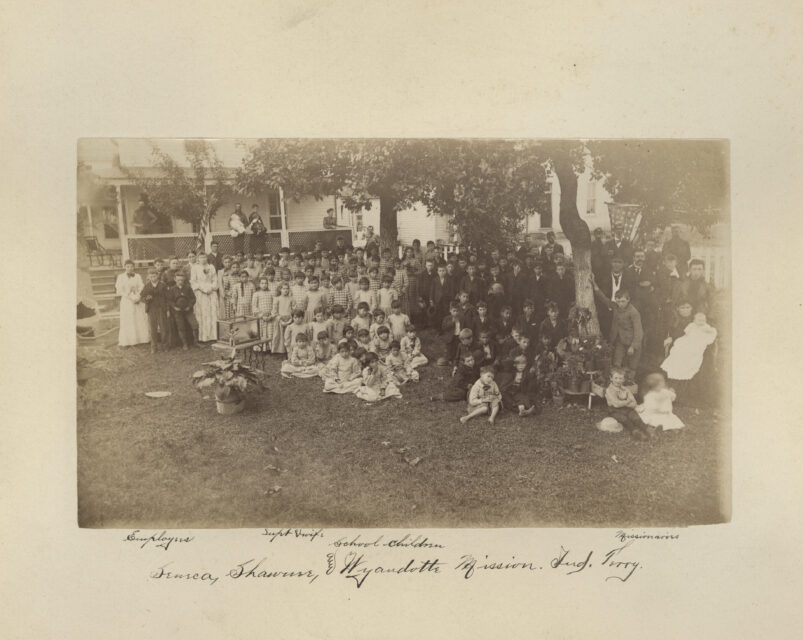NEW YORK (AP) — A coalition advocating for Native American people traumatized by an oppressive system of boarding schools for Native youths plans to digitize 20,000 archival pages related to schools in that system that were operated by the Quakers.
The Quakers and other faith groups — including Episcopalians, Methodists and Catholics — have in recent years either begun or increased efforts to research and atone for their prior roles in the boarding school system that Native children were forced to attend, and that cut them off from their families, tribes and traditions.
For decades, documents related to Quaker-operated Indian boarding schools have been largely unstudied, as they exist in remote and dispersed collections with limited access, said leaders of the National Native American Boarding School Healing Coalition. Now, the coalition, also known as NABS, will make them available to scholars and nonspecialists by housing digital records on a public database.
The records will provide a better understanding of the conditions that children experienced at these schools, and help the compilation of statistics, including how many children went missing and died, said Stephen Curley, director of digital archives for NABS.
“There are hundreds of schools that were operated historically with the sole aim to sever ties between child and family and between child and cultural heritage … so a lot of instances of abuse were administered to these children,” said Curley, a Navajo whose own family was affected by the boarding schools. The records, he said, will be crucial to confirming the anecdotal retelling of their harrowing experiences.
“Not to diminish people speaking up and telling their truths,” Curley said, “but when it comes to providing testimony and having that inform what policy should look like, looking at the records is going to play an integral role to codify what happened next.”
The initiative is funded by a grant of more than $124,000 from the National Historic Publications and Records Commission. It was awarded to NABS to work with Friends Historical Library of Swarthmore College and Quaker & Special Collections at Haverford College, both near Philadelphia.
“This is a profound moment because as we have been calling on churches to increase the accessibility of these records for years now, it’s groups like these at these Quaker institutions who have responded to that call,” said Samuel Torres, deputy CEO of NABS, and a member of the Mexica-Nahua Indigenous people.
Partnership leaders said NABS, Swarthmore and Haverford will scan 20,000 pages of enrollment papers, photographs, financial information, correspondence and administrative records this fall.
The records from Swarthmore and Haverford range from 1852 to 1945, according to project organizers. They include at least nine Quaker-operated Indian boarding schools in Indiana, Kansas, Nebraska, New York, Ohio, Oklahoma and Pennsylvania.
After the scanning, project leaders will hold an information session with tribal communities to discuss the findings. The project will include the production of a video with shared oral histories from boarding school survivors and their families.
“One of the reasons that I think the oral history component is so important is a lot of the records that we’re going to be dealing with in this project are particularly from an institutional perspective, from the people who ran the boarding schools … rather than from the children who were forced to attend those schools,” said Sarah Horowitz, curator of rare books and manuscripts and head of Quaker & Special Collections at Haverford.
“So it’s really important to get to those documents,” she said. “But it also means that those documents are not necessarily telling you, if you read them at face value, the stories of the communities… people may need to read against the grain … to really get at the stories of the children.”
The digitized records will be made publicly available in spring 2024 on a database called the National Indian Boarding School Digital Archive, which NABS will launch later this year.
“Part of the impact of colonialism is that many written records describing the lives of Indigenous people are stored in archives like ours that are far away from descendant communities,” said Celia Caust-Ellenbogen, associate curator for Friends Historical Library of Swarthmore College. She hopes that the partnership opens the way to further discussion of the role those religious institutions had in the operation of the schools.
“Those records can be really important for truth-telling processes and acknowledging and supporting the repair of past harms,” she said. “By making these archival records available, by digitizing these records, we can help restore access to communities that were impacted.”
__
Associated Press religion coverage receives support through the AP’s collaboration with The Conversation US, with funding from Lilly Endowment Inc. The AP is solely responsible for this content.





